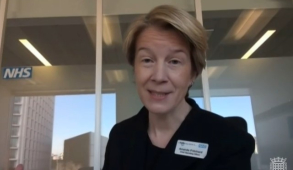Greater productivity required in 2022/23
 The guidance, published on 24 December, said the NHS will be expected to fully restore core services, significantly reduce elective backlogs, and address NHS long-term plan ambitions. On top of long-term plan requirements, the service should take out cost and deliver additional efficiencies – returning productivity to pre-pandemic levels – to address the additional costs of the pandemic response.
The guidance, published on 24 December, said the NHS will be expected to fully restore core services, significantly reduce elective backlogs, and address NHS long-term plan ambitions. On top of long-term plan requirements, the service should take out cost and deliver additional efficiencies – returning productivity to pre-pandemic levels – to address the additional costs of the pandemic response.
It added: ‘The scale of the efficiency requirement will be sustained throughout the [spending review] period and systems should ensure they develop plans that deliver the necessary exit run-rate position to support delivery of future requirements.’
All objectives for 2022/23 are based on Covid returning to a low level, and will be kept under review.
The financial framework for 2022/23 includes a ‘glidepath’ from the current system revenue envelopes to fair share allocations. The guidance confirmed that ICB revenue allocations will be based on the current system funding envelopes, including the funding previously provided to ensure system financial sustainability and a general efficiency requirement. The glidepath will include a convergence adjustment to move systems to their fair share allocation gradually.
There will be greater clarity over capital funding, with three-year allocations at ICB level.
Balanced position
And, subject to Parliament passing the Health and Care Bill, each ICB and their partner trusts will be collectively responsible for delivering a financially balanced system locally. The nationally set funding flow arrangements of the last two years will end in favour of local ownership of commissioning and funding flows, based on partnership to establish payment terms and contract management. Provider elective activity plans will be funded on the aligned payment and incentive approach, with payment linked to the level of activity delivered.
In the guidance, NHS chief executive Amanda Pritchard (pictured) confirmed a new target date for the statutory establishment of ICBs. This is now 1 July, rather than 1 April, to allow time for the required legislation to be passed by Parliament.
Meanwhile, the 42 integrated care systems (ICSs) will continue to develop, and planned financial developments will remain in place, supporting a system-based approach to planning and delivery and based on ICS boundaries agreed in 2021/22. Clinical commissioning groups will remain as statutory organisations until the new arrangements commence, and NHS England and NHS Improvement will retain all direct commissioning arrangements not already delegated to CCGs.
One-year revenue allocations will be issued for 2022/23 shortly, alongside three-year capital allocations up to 2024/25. Total capital funding for the next three years will be £23.8bn, which includes £4.2bn to support the building of 40 new hospitals and to upgrade 70 hospitals, £2.3bn to transform diagnostic services, £2.1bn for digital technology, and £1.5bn to support elective recovery.
NHS England is aiming to publish revenue allocations for 2023/24 and 2024/25 in the first half of 2022/23. Capital allocations will be partly used to increase diagnostic activity to a minimum of 120% of pre-pandemic levels in 2022/23, while systems should develop investment plans to further expand the new community diagnostic centres in 2023/24 and 2024/25.
10 priorities
The planning guidance sets out 10 priorities for 2022/23. These are:
- Invest in the workforce, recruiting more staff – for example to additional primary care roles and to tackle substantive gaps in acute care – and adopting new ways of working. NHS organisations should also focus on improving the black, Asian and minority ethnic disparity ratio, and promote equality across all protected characteristics.
- Respond more effectively to Covid-19, through the vaccination programme and meeting the needs of patients with Covid by, for example, using new treatments.
- Deliver significantly more elective care to tackle backlogs. Every system must develop an elective care recovery plan for 2022/23. The NHS in England aims to provide 30% more elective activity than before the pandemic by 2024/25, and the ambition is for a 10% increase in 2022/23. Long waits should be tackled, including eliminating waits of more than 104 weeks, reducing those over 52 weeks, and cutting outpatient follow-ups by 25% against 2019/20 activity by March 2023. Specific system targets will be agreed through the planning process. Systems delivery plans should reflect how they will use additional revenue (£2.3bn in 2022/23) and capital funding (totalling £1.5bn over three years) across elective inpatient, outpatient, and diagnostic services to meet these ambitions.
- Improve urgent and emergency care responsiveness and build community care capacity. This will be supported by creating the equivalent of 5,000 additional beds, particularly through virtual ward models, eliminating 12-hour waits in emergency departments and minimising ambulance handover delays. Up to £200m will be available for the development of virtual wards in 2022/23 and up to £250m the following year.
- Increase timely access to primary care, using investment in primary care and primary care networks to raise capacity and push forward integrated working and neighbourhood and place level.
- Improve mental health services and services for people with a learning disability and/or autism. Over the next three years, £150m of targeted national capital funding will be available to support improvements in mental health urgent and emergency care. Delivery of the mental health investment standard will remain a minimum requirement, and, where service development funding supports ongoing services, these will continue to be funded beyond 2023/24. Systems should develop a mental health workforce plan to 2023/24, while system capital funding should support urgent patient safety projects. Funding to eradicate mental health dormitories will continue in 2022/23 and 2023/24.
- Continue the development of population health management to prevent ill-health and address health inequalities.
- Transform care delivery and patient outcomes by adopting digital technologies. A core level of digitisation is essential in every service by March 2025, the plan said, and costed three-year digital investment plans should be finalised by June 2022. While these plans are developed, initially £250m of capital funding will be allocated to systems in 2022/23.
- Effective use of resources to move back to and over pre-pandemic levels of productivity when the Covid context allows
- Establish ICBs and system working, developing five-year strategic plans in collaboration with local authorities and other partners.
NHS Providers chief executive Chris Hopson (pictured) said workforce was key to the delivery of much of the planning guidance. ‘Eight of the 10 priorities in this programme won’t be fully possible without addressing the first – securing a properly costed and funded workforce plan is fundamental to the future success of the NHS.

‘Trusts tell us that workforce capacity is the constraining factor in the health and care system at the moment, underpinned by a lack of national long-term plan, challenges with recruitment, and rising staff absences connected with Covid-19.
‘While recognising the fundamental importance of elective recovery, this cannot be accomplished without stabilising the situation in urgent and emergency care, primary care, and social care, and addressing growing demand and a backlog of care in community and mental health services,’ he added.
The HFMA has produced a summary of the planning guidance, available here
Related content
We are excited to bring you a fun packed Eastern Branch Conference in 2025 over three days.
This event is for those that will benefit from an overview of costing in the NHS or those new to costing and will cover why we cost and the processes.